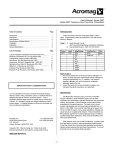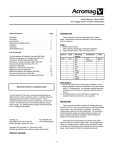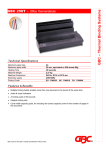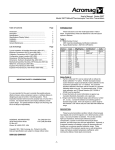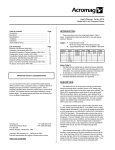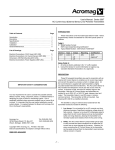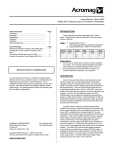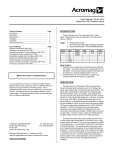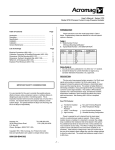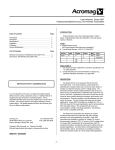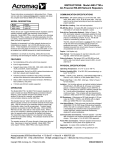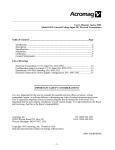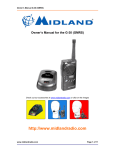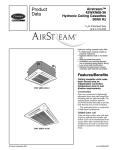Download - 1 - User`s Manual: Series 250T DC Current/Voltage Two
Transcript
User's Manual: Series 250T DC Current/Voltage Two-Wire Transmitters Table of Contents Page Introduction............................................................................ Description............................................................................. Specifications ........................................................................ Specifications (Display Option).............................................. Installation ............................................................................. Calibration ............................................................................. General Maintenance ............................................................ List of Drawings INTRODUCTION: These instructions cover the model types listed in Table 1 below. Supplementary sheets are attached for units with special options or features. 1 1 2 3 4 4 6 Table 1: A. Model Number Format: 250T-Input-Mounting/Display-Certification-Calibration B. Typical Model Number: 250T-C1-XP-NCR-C Page Electrical Connections: DC C/V Input (4501-097)................. Configuration Jumper Location (4501-096)........................... Dimensions: DIN Rail Mounting (4501-080).......................... Dimensions: Surface & Snaptrack Mtg. (4501-081).............. Mechanical Assy: Mounting -XP Enclosures (4501-082)....... NEMA 4 & 12 Enclosures (4501-083)................................... Explosion Proof Enclosure (4501-084).................................. Explosion Proof Enclosure, with Window (4501-085)............ 7 8 9 10 11 12 13 14 -Input 250T -C1 -V1 -V2 -V3 -V4 -V5 -V6 -Mounting/ Display -DIN -SM -ST -N4 -N12 -XP -XPD1 XPD2 XPD3 -Certification -Calib. -NCR 2 -Approval (Blank) 1 -C Notes (Table 1): 1. Unit can be ordered with or without the factory calibration "-C" option. All other input types automatically include calibration to the customer's specification (no "-C" needed). Any customer specified calibration info will be included on a separate calibration label on the unit. 2. Consult the factory for current information on agency (e.g. Canadian Standards Association, etc.) approvals. IMPORTANT SAFETY CONSIDERATIONS DESCRIPTION: It is very important for the user to consider the possible adverse effects of power, wiring, component, sensor, or software failures in designing any type of control or monitoring system. This is especially important where economic property loss or human life is involved. It is important that the user employ satisfactory overall system design. It is agreed between the Buyer and Acromag, that this is the Buyer's responsibility. ACROMAG, INCORPORATED 30765 South Wixom Road PO Box 437 Wixom, MI 48393-7037, USA Series These two-wire transmitters condition DC voltage (either unipolar or bipolar), from 100mV to 100V DC spans, and convert the signal to a 4 to 20mA process current output. Input circuit isolation is standard. The unit also provides high input impedance (voltage inputs) and wide range zero and span adjustments. The transmitters are RFI-protected, operate over large temperature ranges, and feature excellent temperature coefficients, which minimize the effects from the plant environment. Following the basic two-wire design, the output and the DC power share the same pair of twisted copper wires. The transmitter, acting similar to a variable resistor in series with the load and the DC supply, provides an output loop current proportional to the input sensor signal. Tel: (248) 624-1541 FAX: (248) 624-9234 These field mounted two-wire transmitters are designed to utilize one of a number of customer-specified mounting configurations. The transmitter is available for DIN-rail mounting, surface mounting, 3-inch SNAPTRACK plastic rail mounting, or in various housings. These housings include NEMA 4, 12, and explosion-proof enclosures. The model number of the unit specifies the mounting/ enclosure type. Copyright 1991, 1994, Acromag, Inc., Printed in the USA. Data and specifications are subject to change without notice 8500-283-C94F009 -1- Series 250T User's Manual DC Current/Voltage Two-Wire Transmitters __________________________________________________________________________________________ Power: An external loop power supply is required: 12V DC minimum, 50V DC maximum. Under no circumstances must the DC supply ever exceed 75 volts peak instantaneously. Unit has reverse polarity protection. The transmitter mounted in the explosion-proof enclosure is available with a 3-1/2 digit LCD readout (1/2-inch height) to provide a visual indication of the transmitter's output. The readout is available in percent-of-span or engineering units and scaled to customer requirements. Output Limits: 3.8mA DC to 26mA DC, typical. Input wiring is inserted in the bottom of the unit, while output wiring is inserted in the top of the unit. Screws to secure the wiring are located on the front panel. Connectors are screw-clamp type and accept wire size up to #14 AWG. Load Resistance Range Equation: R-Load (Maximum) = (V supply - 12V) / 20mA At 24V supply, R-Load = 0 to 600 ohms. Power Supply Effect: DC Volts: ±0.001% of output span per volt DC. 60/120 Hz ripple: ±0.01% of output span per volt peak-to-peak of power supply ripple. SPECIFICATIONS: Function: This family of isolated two-wire transmitters condition either a DC current or voltage signal, provide input circuit isolation, and convert the input signal to a 4 to 20mA process current output. Wide range zero and span adjustments utilize 22-turn potentiometers accessible from the front of the unit. The transmitter has various mounting and enclosure options available. Input Impedance: Per input type, see input description above. Reference Test Conditions: Input: 1 to 5V DC, 100 ohm resistive source; output: 4-20mA into a 500 ohm load; 77oF (25oC); +24V DC supply. Accuracy: Better than ±0.1% of calibrated span or ±0.25mV, whichever is greater. The error includes the combined effects of transmitter repeatability, hysteresis, terminal point linearity, and adjustment resolution. MODEL/SERIES: 250T- (Color Coded with a White Label) INPUT: DC Current and Voltage. Input span and zero ranges are adjustable as specified below, except for special ranges which are factory calibrated per customer specifications. Both the Span and Zero adjustment capability are covered in two ranges, and are configured by internal jumpers on the circuit board. Ambient Temperature Range: -13oF to 185oF (-25oC to 85oC). Ambient Temperature Effect: Less than ±0.01% of output span per oF(± 0.018% per oC) over the ambient temperature range for reference test conditions (specification includes the combined effects of zero and span over temperature). -C1: DC Current: Span: 4.0 to 20.0mA DC. Zero: 0.0 to 16.0mA DC. Maximum full scale of 20.0mA DC. Input load is 10 ohms. -V1: DC Voltage: Span: 0.1 to 1.0V DC. Zero suppression from 0 to 25 percent of input span. Input impedance is 40M ohms at 0.4V span, typical; input current ±10nA, typical. -V2: DC Voltage: Span: 1.0 to 10.0V DC. Zero suppression from 0 to 25 percent of input span. Input impedance is 100K ohms, typical. -V3: DC Voltage: Span 10.0 to 100.0V DC. Zero suppression from 0 to 25 percent of input span. Input impedance is 500K ohms, typical. -V4: DC Voltage, bipolar input: Span ± 0.1 to ± 1.0V DC. Signal is assumed to be symmetrical around 0 volts. Input impedance is 80M ohms at 0.8V span, typical; input current ±10nA, typical. -V5: DC Voltage, bipolar input: Span ±1.0 to ±10.0V DC. Signal is assumed to be symmetrical around 0 volts. Input impedance is 100K ohms, typical. -V6: DC Voltage, bipolar input: Span ±10.0 to ±100.0V DC. Signal is assumed to be symmetrical around 0 volts. Input impedance is 500K ohms, typical. Load Resistance Effect: Less than ± 0.005% of output span for 100 ohm change. Output Ripple: Less than ±0.25% of the maximum output span. Can be reduced to less than ±0.1% by adding a 1uF capacitor across the load resistor. Some loads (such as E/P and I/P devices) may require a 0.1uF capacitor to be inserted across the load. Bandwidth: -3dB at 3 Hz, typical. Response Time: For a step input, the output reaches 98% of output span in 300ms, typical. Noise Rejection: Common Mode: 120dB at 60 Hz, 100 ohm unbalance, typical. Normal Mode: 30dB at 60 Hz, 100 ohm source, typical. RFI Resistance: Less than ± 0.5% of output span change with RFI field strengths of up to 10V/meter at frequencies of 27MHz, 151MHz, and 467MHz. Isolation: The input circuit is electrically isolated from output/power circuits, allowing the input to operate at up to 250V AC, or 354V DC off ground, on a continuous basis (will withstand 1500V AC dielectric strength test for one minute without breakdown). Complies with test requirements outlined in ANSI C39.5-1974 for the voltage rating specified. EMI Resistance: Less than ±0.25% of output span effect with switching solenoids or commutator motors. Surge Withstand Capability (SWC): Input/Output terminations are rated per ANSI/IEEE C37.90-1978. Unit is tested to a standardized test waveform that is representative of surges (high frequency transient electrical interference), observed in actual installations. Output: 4-20mA DC output. Note: A Test Signal of 40mV to 200mV is available at the output terminals, (see Drawing 4501-097); it represents the 4 to 20mA output. -2- Series 250T User's Manual DC Current/Voltage Two-Wire Transmitters __________________________________________________________________________________________ Construction (Basic Transmitter): Circuit Boards: Military grade FR-4 epoxy glass circuit board. Circuit Board Coating: Fungus resistant acrylic conformal coat. Terminals: Compression type, wire size 14 AWG maximum. Mounting Position: Position insensitive. -XPD3: Explosion Proof, Water-Tight Enclosure (With Window). Includes the Engineering Units Display Option (D3). Shipping weight: 6 pounds (2.7Kg) packed. DISPLAY OPTION: The Display is available as an option when specifying the "-XP" Housing. The linear display option assembly includes zero and span trim adjustments. Display Options include: MOUNTING/DISPLAY: A wide variety of mounting options and enclosures are available to meet the needs of the installation. The available models are listed below. The transmitter is shipped as a complete assembly. -xxD1: Standard Display Option (D1): The minimum and maximum input (any calibration) is represented by 00.0 and 100.0% on the display (normalized). It also represents the 4 to 20mA transmitter output, a resolution of 0.1% of span. -xxD2: Temperature Display Option (D2): Not applicable. -xxD3: Engineering Units Display Option (D3): The minimum and maximum display readings correspond to the minimum and maximum display readings specified for the unit by the customer. General Purpose Housing: Available with various mounting options listed below. Case: Self-extinguishing NYLON Type 6.6 polyamide thermoplastic UL94 V-2, color black. -DIN: General Purpose Housing, DIN Rail-Mount - "G" & "T" rails. "G" Rail (32mm), Type EN50035; "T" Rail (35mm), Type EN50022. Refer to Drawing No. 4501080 for outline and clearance dimensions. Shipping Weight: 1 pound (0.45Kg) packed. -SM: General Purpose Housing, Surface-Mount. Refer to Drawing No. 4501-081 for outline and clearance dimensions. Shipping Weight: 1 pound (0.45Kg) packed. -ST: General Purpose Housing, SNAPTRACK™. Refer to Drawing No. 4501-081 for outline and clearance dimensions. Shipping Weight: 1 pound (0.45Kg) packed. SNAPTRACK™ is a registered trademark of Reed Devices, Inc. Display Range: The minimum display reading can be from -1999 to +1999 counts, while the span range can be from 100 to 2000 counts (span counts = maximum counts minus minimum counts--Note: mentally remove the decimal point to determine the display counts). The decimal point is configured as required (such as 00.0 to 100.0%). Display Characteristics: The 7-segment reflective Liquid Crystal Display (LCD) contains 3-1/2 digits (1999) with 1/2 inch character height. Also includes a factory programmed 3 position decimal point. Optimal view angle is 60 degrees. NEMA 4 and 12 Enclosures: Option types listed below. Refer to Drawing No. 4501-083 for outline and clearance dimensions. Transmitter is mounted within the enclosure at the factory. These enclosures can also accommodate a second Series 250T transmitter with the surface-mount option (-SM option), ordered separately. Conduit mounting holes and fittings are customer supplied. No Output Burden: Provides a visual indication of the transmitter output without reducing the output compliance (the allowable load resistance range). Water-Tight Enclosure, NEMA 4. Enclosure material and finish: 0.075 and 0.060 inch thick steel with gray hammertone enamel finish inside and out. Shipping weight: 6 pounds (2.7Kg) packed. -N12: Oil-Tight Enclosure, NEMA 12. Enclosure material and finish: 0.075 and 0.060 inch thick steel with gray hammertone enamel finish inside and out. Ship. weight: 6 pounds (2.7Kg) packed. Display Ambient Temperature Range: Operating: 0 oC to +50oC (+32 to +122oF); Storage: -20 oC to +70oC (-4oF to +158oF). Explosion Proof, Water-Tight Enclosures: Option types listed below. Refer to Drawing 4501-084 (no display window) or Drawing 4501-085 (with display window) for outline and clearance dimensions. Enclosure Materials: Body and cover Copper-free aluminum (less than 0.4%), Glass lens - Heat tempered glass, Gasket - Neoprene. Finish: Corro-free epoxy powder coat, color gray. Hub size: 0.75 inch (Quantity 2). Housing meets Class I - Groups B, C, & D, Class II - Groups E, F, & G, Class III, and NEMA 4 (water-tight) requirements. Transmitter is mounted within enclosure at factory. Display Ambient Temperature Effect: ± 0.02% per oC (± 0.012% per oF), typical. -N4: Over-range: The three lower order digits blank for >1999 counts. Display Accuracy: ± (0.1% of reading + 2 counts). Conversion Rate: 2.5 per second. CERTIFICATION: Consult the factory for current information on the availability of agency (e.g. Canadian Standards Association, Factory Mutual, etc.) approvals. -NCR: No Certification Required. -XP: Explosion Proof, Water-Tight Enclosure (No Window). Shipping weight: 5 pounds (2.3Kg) packed. -XPD1: Explosion Proof, Water-Tight Enclosure (With Window). Includes the Standard Display Option (D1). Shipping weight: 6 pounds (2.7Kg) packed. -XPD2: Explosion Proof, Water-Tight Enclosure (With Window). Includes the Temperature Display Option (D2). Shipping weight: 6 pounds (2.7Kg) packed. -3- Series 250T User's Manual DC Current/Voltage Two-Wire Transmitters __________________________________________________________________________________________ INSTALLATION: Electrical Connections: The transmitter is packaged in a general purpose plastic housing and optionally mounted within a variety of protective enclosures. The transmitter should be located in an area that is protected from dust, moisture, and corrosive atmospheres. The enclosure type determines the protection afforded in a particular environment and location, make sure that this is not compromised. Maximum operating ambient temperatures should be within -13 oF to 185oF (-25 oC to 85oC) for satisfactory performance. If the unit is factory calibrated, it is ready for installation. Connect as shown in Connection Drawing 4501-097. If the unit is not factory calibrated, refer to the "CALIBRATION" section. The wire size used to connect the unit to the control system is not critical. All terminal strips can accommodate wire from 14-26 AWG. Strip back wire insulation 1/4-inch on each lead before installing into the terminal block. Input wiring may be shielded or unshielded twisted pair. Output wires should be twisted pair. Since common mode voltages can exist on signal wiring, adequate wire insulation should be used and proper wiring practices followed. It is recommended that output/power wiring be separated from the signal wiring for safety, as well as for low noise pickup. 1. Output/Power: Connect DC power supply and load per Connection Drawing 4501-097. These transmitters operate from DC power supplies only. Power supply voltage is not critical and normally should be from 12-50V DC. The supply voltage must not exceed 75 volts, even instantaneously. Further, the power supply voltage must be adequate to furnish full-scale current to the load(s), plus transmission line drop, plus 12V DC terminal voltage to the transmitter. Variations in power supply voltage or load resistance have negligible effect on transmitter accuracy. Mounting: To mount the transmitter assembly, determine which configuration is utilized and consult the proper mounting instructions below and refer to the appropriate outline drawing for mounting and clearance dimensions. DIN Rail Mounting: Use suitable fastening hardware to secure the DIN rail to the designated mounting surface. A transmitter ordered with the DIN Rail mounting option (-DIN) can be mounted to either a "T" or "G" Rail. Installation of the transmitter to the rail depends on the type of DIN rail used (see Drawing 4501-080). Units can be mounted side-by-side on 1.0-inch centers, if required. Ripple and Noise: Power supply ripple at 60Hz/120Hz is reduced at the load by the transmitter. The ripple at the load will be 0.01% of span per volt peak to peak of power supply ripple. The unit may have up to 0.25 percent of internally generated ripple. In this case, connect an external 1uf capacitor across the load to reduce this ripple to less than 0.1% if desired. Surface Mounting: Secure the transmitter to the designated mounting surface using two 6-32 screws. The mounting bracket has screw slots to facilitate mounting. Units can be mounted side-by-side on 1.0-inch centers, if required. 2. Grounding: The two-wire transmitter is packaged in a general purpose plastic housing and does not require an earth ground connection. If the transmitter is mounted in a metal housing, a ground wire connection is required. Connect the ground terminal (green screw) to a suitable earth ground using suitable wire per applicable codes. SNAPTRACK™ Mounting: Secure the SNAPTRACK™ mounting channel to the designated mounting surface using suitable fastening hardware. To install the unit in the mounting channel, place the bottom end of the mounting bracket between the rails and press the top (notched end) firmly until the bracket "snaps" into place. To remove the transmitter, insert a screwdriver into the upper arm of the connector and twist to release the unit from the track and tip the unit out. Units can be mounted side-by-side on 1.0-inch centers, if required. 3. Input: Connect input per connection diagram. If unit is factory calibrated, calibration label indicates range of input. Note: The input circuit is electrically isolated from the output/power circuit allowing the input to operate up to 250V AC, or 354V DC, off ground on a continuous basis. NEMA 4 & 12 Enclosure Mounting: Secure the enclosure assembly to the designated mounting surface using appropriate hardware. The transmitter is secured within this enclosure using two screws. CALIBRATION: A. TRANSMITTER: Note: It is recommended that the transmitter be removed from the enclosure during the process of drilling holes, installing fittings, and mounting the enclosure. This section provides information for unit configuration and calibration. If the unit was factory calibrated, jumpers have been placed in their proper positions and verification of the calibration can be made per the Adjustment Procedure. If the calibration of the unit is to be changed, first go to the "Shunt Block Configuration Procedure", before going to the Transmitter Adjustment Procedure." NEMA Explosion-Proof Mounting: Secure the enclosure assembly to the designated mounting position using appropriate hardware. Note: It is recommended that the transmitter be removed from the enclosure during the process of mounting the enclosure. To remove the unit from the enclosure, remove the two screws securing it to the bottom of the enclosure. After the enclosure is installed, install the transmitter into the enclosure. Position the unit at an angle that permits all wiring to be routed unobstructed through both ports. If the transmitter has the display option, make sure the orientation of the display allows for easy reading once installed. Secure the transmitter assembly to the enclosure using two screws. 1. Transmitter - Shunt Block Configuration Procedure: The Zero and Span adjustment ranges are configured by internal jumpers (refer to Drawing 4501-096 for details). To gain access to the configuration jumpers, first remove the transmitter from the installation. Second, remove the circuit boards from the plastic enclosure as described in the Disassembly Procedure below. Third, configure the jumpers (shunt blocks) as described in the Jumper Configuration procedure below. Note, calibration per the Adjustment Procedure should be performed before the circuit boards are reassembled within the plastic enclosure. -4- Series 250T User's Manual DC Current/Voltage Two-Wire Transmitters __________________________________________________________________________________________ Disassembly Procedure for the 250T Plastic Housing: For optimum performance, the span and zero capability of the unit are covered in two ranges which are programmed by internal jumpers on the circuit board. The Span (S) and Zero (Z) jumpers change the range of adjustment of the span and zero potentiometers. If during calibration the zero potentiometer range is found to be inadequate, move the Zero Shunt from "IN" (Default Position) to "OUT". If during calibration the span potentiometer range is found to be inadequate, move the Span Shunt from "IN" (Default Position) to "OUT". Only move the Shunt Jumpers when it is required. For Shunt Block location refer to Drawing 4501-096. The plastic housing has no screws, it "snaps" together. A flatheadscrewdriver (Acromag 5021-216 or equivalent) is needed to pry thehousing apart as described in the following steps. CAUTION: Do not push the screwdriver blade into the housing more than approximately 0.1 inches while prying it apart. Handling of the printed circuit boards should only be done at a static-free workstation, otherwise, damage to the electronics could result. 1. To begin disassembly (refer to Drawing 4501-088) place the screwdriverat point A (left side of the transmitter). While pressing the blade into the seam, use a twisting motion to separate the sides slightly. Repeat this operation at point B. Calibration Example 1 (C1,V1,V2 and V3 models are similar): MODEL: 250T-V1-XPD1-NCR Input: 0 to 1.0V DC. Output: 4-20mA 2. Now that the two pieces have been partially separated, use the screw-driver blade to work the left side of the package loose by working around the transmitter and carefully prying the sides further part. Repeat this action until it is easy to remove the left side from the plastic pins holding the pieces together. 1. Set the input source to 0.000V DC. Adjust the Zero (Z) pot until the output reads 4.000mA DC. 2. Set the input source to 1.000V DC. Adjust the Span (S) pot until the output reads 20.000mA DC. 3. Repeat steps 1 and 2 above, until the readings converge. The instrument is now calibrated. Several mid-point values should also be checked to verify proper operation of the transmitter. 4. After the above calibration procedure is complete, install the transmitter PC Board assembly back into its case as described in the assembly procedure below. Note: If the transmitter has the Display Option, install it at this time also. 3. Repeat this operation for right side starting at points C and D. CAUTION: If the two pc boards become separated while taking the package apart, re-align the boards making sure that the two headers (pins) and sockets at locations E and F are properly aligned and carefully push the boards back together. Jumper Configuration (Shunt Blocks): Calibration Example 2 (V4,V5 and V6 models are similar) : Shunt blocks are provided to accommodate in-field configuration changes.In case of misplacement, additional shunt blocks may be ordered from the factory. When ordering additional shunt blocks, refer to Acromag Part Number 1004-332. MODEL: 250T-V4-XPD1-NCR Input: -0.4 to 0.4V DC. Output: 4-20mA 1. Set the input source to 0.0000V DC. Adjust the Zero (Z) pot until the output reads 12.000mA DC. 2. Set the input source to -0.4000V DC. Adjust the Span (S) pot until the output reads 4.000mA DC. 3. Set the input source to 0.4000V DC. Take note of how far the output is from 20.000mA DC. Adjust the Span (S) pot to reduce the difference from 20.000mA DC by half. Adjust the Zero (Z) pot until the output reads 20.000mA DC. 4. Repeat steps 2 and 3 until the readings converge. The instrument is now calibrated. Several mid-point values should also be checked to verify proper operation of the transmitter. 5. After the above calibration procedure is complete, install the transmitter PC Board assembly back into its case as described in the assembly procedure below. Note: If the transmitter has the Display Option, install it at this time also. 1. Zero / Span Range: The Zero and Span shunt blocks should initially be placed in their default position, typically "IN" for each case, see Drawing 4501-096. During the process of Calibration, the need to change these jumper positions will be determined. 2. Important: Mark the Transmitter's Configuration on the calibration label located on the enclosure. Example: IN: 0 to 1.0V DC. Jumper Configuration Example: Configure internal jumpers as follows: A. Zero / Span Range: Zero & Span Jumpers both "IN". 2. Transmitter Adjustment Procedure: Connect the transmitter as shown in Connection Drawing 4501-097. For best results, the input signal source should be adjustable over the entire input range of the unit and settable to an accuracy of 0.1% or better, and have a source resistance of 100 ohms or less. The power supply voltage must be adequate to furnish full-scale current to the load, plus wire drop, plus 12V DC terminal voltage to the transmitter. The output current must be measured to 0.1% accuracy or better for proper results. Assembly Procedure for the 250T Plastic Housing: NOTE: The Model/Serial Number label is attached to the left side. 1. Refer to Drawing 4501-096 and line up the left plastic side with the board and terminal assembly. Carefully but firmly press the pieces together. 2. Before installing the right side, place the mounting bracket (unique to the mounting type you have) around the pins at the back of the housing. 3. Line up the right side of the housing with the assembly and carefully but firmly press the pieces together. The Zero and Span adjustments are accessible on the front panel of the transmitter (see Drawing 4501-097 for location). The screwdriver blade, used to adjust the potentiometers, should not be more than 0.1 inch (2.54mm) wide. -5- Series 250T User's Manual DC Current/Voltage Two-Wire Transmitters __________________________________________________________________________________________ B. DISPLAY: Display - Adjustment Procedure: If the unit you are calibrating has a display, it is calibrated separately from the transmitter. However, the calibration of the transmitter must be verified FIRST (see above procedure), before verifying the calibration of the display module. Refer to Drawing 4501-097 for location of Transmitter's Zero and Span adjustments and the location of the Display's Zero and Span adjustments. NOTE: The display option is factory configured for a particular customer specified range -- the Zero (DZ) and Span (DS) adjustments are fine trim adjustments only. Display - Calibration Example: MODEL: 250T-V1-XPD1-NCR Input: 0 to 1.0V DC. Display: 0 to 100.0% 1. Set the input source to 0.000V DC. (the Zero point of the transmitter's span). Adjust the Zero (DZ) pot of the Display module for the zero of the display range, 0.0% in this example. 2. Set the input source to 1.000V DC. (the full-scale point of the transmitter's span). Adjust the Span (DS) pot on the Display module for the correct full-scale display reading, 100.0% in this example. 3. Repeat steps 1 and 2 until the readings converge. The display is now calibrated. GENERAL MAINTENANCE: The transmitter contains solid-state components and requires no maintenance, except for periodic cleaning and calibration verification. When a failure is suspected, a convenient method for identifying a faulty transmitter is to exchange it with a known good unit. It is highly recommended that a non-functioning transmitter be returned to Acromag for repair, since Acromag used tested and burned-in parts, and in some cases, parts that have been selected for characteristics beyond that specified by the manufacturer. Further, Acromag has automated test equipment that thoroughly checks the performance of each transmitter. -6-
















